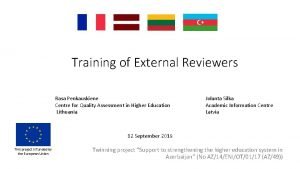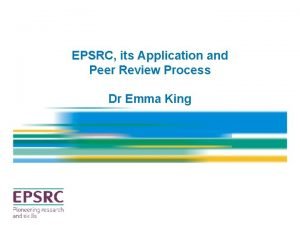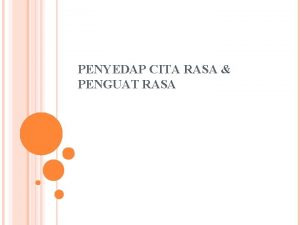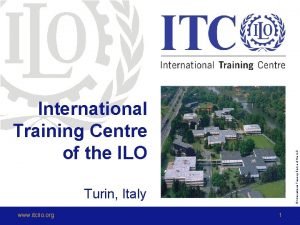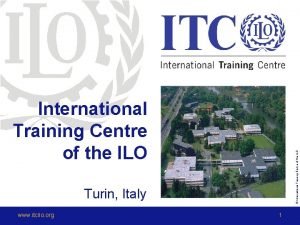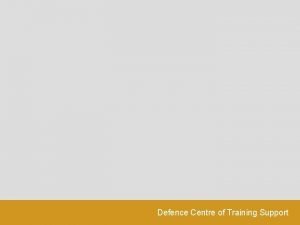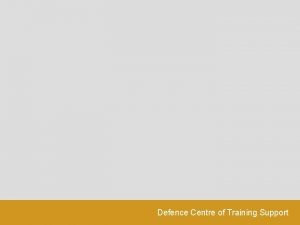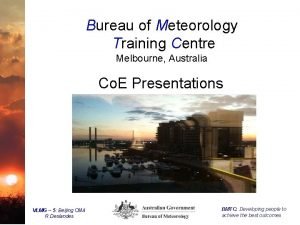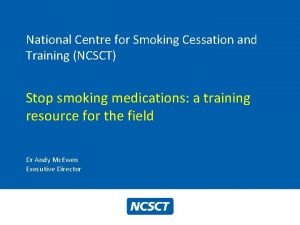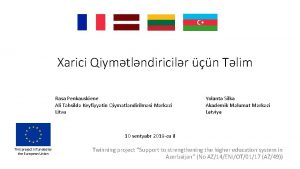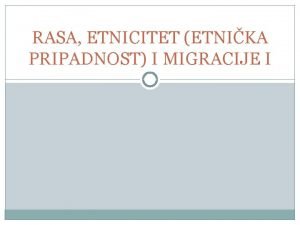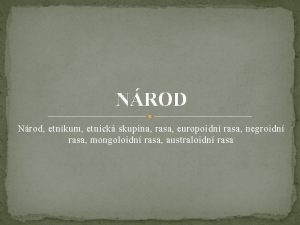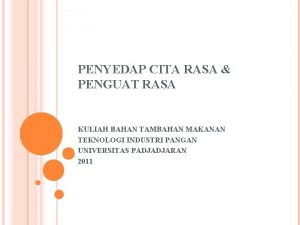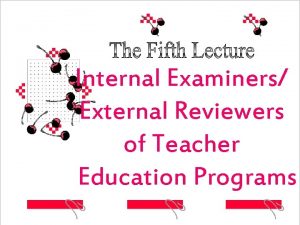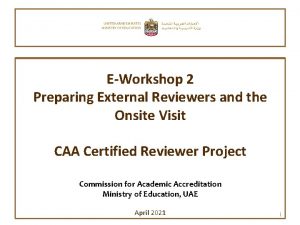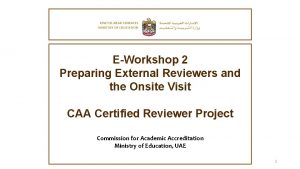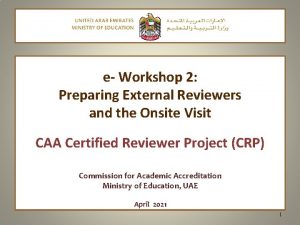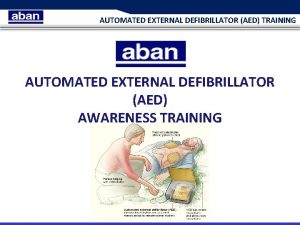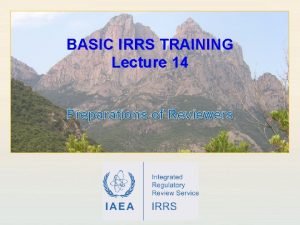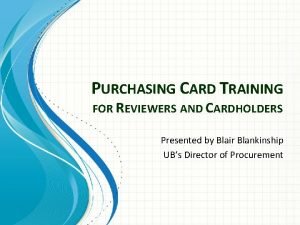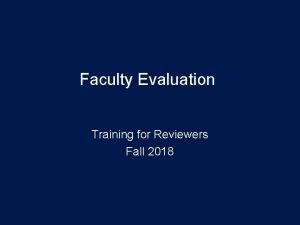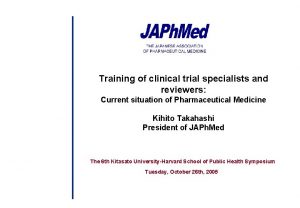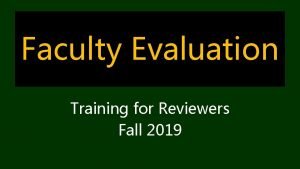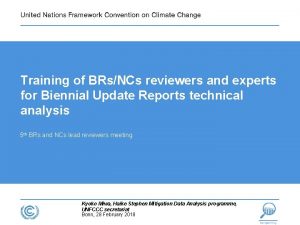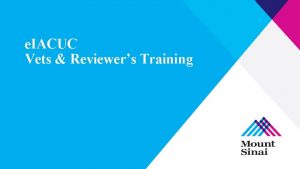Training of External Reviewers Rasa Penkauskiene Centre for




































- Slides: 36

Training of External Reviewers Rasa Penkauskiene Centre for Quality Assessment in Higher Education Lithuania Jolanta Silka Academic Information Centre Latvia 10 September 2019 This project is funded by the European Union Twinning project “Support to strengthening the higher education system in Azerbaijan” (No AZ/14/ENI/OT/01/17 (AZ/49))

Outline • Introductory part • Session 1: Methodology, criteria and indicators for study programme evaluation • Session 2: Practical exercises on how to work with self-evaluation reports

European Higher Education Area

Bologna Process and Quality Assurance • One of the purposes of the Bologna Declaration (1999) was to encourage European cooperation in quality assurance of higher education with a view to developing comparable criteria and methodologies. • The European Ministers of Education adopted in 2005 the "Standards and Guidelines for Quality Assurance in the European Higher Education Area (ESG)" drafted by the European Association for Quality Assurance in Higher Education (ENQA) in co-operation and consultation with its member agencies and the other members of the “E 4 Group” (ENQA, EURASHE and ESU). • A new version of ESG was adopted in 2015 at Yerevan.

Quality Assurance is an important tool: • To inform the labour market about graduate skills and competencies • To guarantee that certain minimum standards are met • To ensure that the qualification awarded meets its stated purpose • To demonstrate that public funds are spent effectively • Assure accountability of Higher Education Institutions • Promote continuous enhancement of higher education

What do we mean with quality assurance? Internal and external process and criteria to: • Ensure minimum standards (accountability) • Support quality enhancement • Provide reliable and transparent information to users and stakeholders (consumer protection) • Create trust in the HE system and its components • Ensure, fundamentally, that students (can) reach the intended learning outcomes Quality Assurance: • what are you trying to do? • how are you trying to do it? • how do you know it works? • what do you need to change in order to improve?

Main principles for QA in EHEA • HEIs have primary responsibility for the quality of their provision and its assurance • QA responds to the diversity of higher education systems, institutions, programmes and students • QA supports the development of a quality culture • QA takes into account the needs and expectations of students, all other stakeholders and society

ESG 2015 purposes • set a common framework for quality assurance systems for learning and teaching at European, national and institutional level • enable the assurance and improvement of quality of higher education in the European Higher Education Area • support mutual trust, thus facilitating recognition and mobility within and across national borders • provide information on quality assurance in the EHEA • ESG the core document for all operations

Scope of the ESG 2015 • Standards and guidelines for quality assurance, not quality as such • Apply to all higher education offered in the EHEA regardless of the mode of study or place of delivery • Apply to all types of QA activities and agencies (quality audits, programme accreditation, institutional review. . . ) • Quality assurance can serve a variety of purposes: enhancement – accountability • Generic, not specific: provide the framework and common basis for national and institutional activities

European Standards and Guidelines (ESG) Part 1 Part 2 • for Internal QA within Higher Education Institutions (10 standards) • the corner stone of QA in HE • for External QA of Higher Education (7 standards) • a condition of the credibility of the results of the internal evaluation Part 3 • for External QA Agencies (7 standards) • external evaluators (QA agencies) are accountable for the quality of their activities

Example – how the standards of the ESG are taken into account in assessment methodologies ESG 2015 Study programme evaluation methodology in Azerbaijan 1. 5 Teaching staff Standard: Institutions should assure themselves of the competence of their teachers. They should apply fair and transparent processes for the recruitment and development of the staff. Evaluation area 3 Teaching staff Guidelines: The teacher’s role is essential in creating a high quality student experience and enabling the acquisition of knowledge, competences and skills. The diversifying student population and stronger focus on learning outcomes require student-centred learning and teaching and the role of the teacher is, therefore, also changing (cf. Standard 1. 3). Higher education institutions have primary responsibility for the quality of their staff and for providing them with a supportive environment that allows them to carry out their work effectively. Such an environment - sets up and follows clear, transparent and fair processes for staff recruitment and conditions of employment that recognise the importance of teaching; - offers opportunities for and promotes the professional development of teaching staff; - encourages scholarly activity to strengthen the link between education and research; - encourages innovation in teaching methods and the use of new technologies. Criteria: 3. 1. The study programme is provided by the staff meeting legal requirements; 3. 2. The qualifications of the teaching staff are adequate to ensure learning outcomes; 3. 3. The number of the teaching staff is adequate to ensure learning outcomes; 3. 4. Teaching staff turnover is able to ensure an adequate provision of the programme; 3. 5. There are conditions in the higher education institution for the professional development of the teaching staff; 3. 6. The teaching staff of the programme is involved in research (art) directly related to the study programme being reviewed. 3. 7. Recruitment of teaching staff is fair and transparent and open to pubic, taking into account their teaching and research activity.

Methodology, criteria and indicators for study programme evaluation Session 1

The main parties involved in the assessment process • Higher education institution whose study programme is being evaluated • ANO • Experts group composed by ANO • Accreditation Council – decision making body

General Steps of Procedures 1. Self-assessment process 2. Submission of the application and self-assessment report 3. Review of the documents by the Agency 4. Composing the experts group 5. Experts work before the site visit 6. Visit of the experts group 7. Joint report of the experts group 8. Comments by HEI on the factual errors 9. Decision by the Committee (with the HEI present) 10. Follow-up procedures

Process of accreditation

The experts group: • • • takes part in the experts training organised by ANO; divides tasks between the members of the experts group; analyses beforehand the self-evaluation report and other documents; identifies the issues to be looked into during the site visit and prepares questions for the site visit; takes part in the preparatory meetings; takes part in the site visit according to the agreed agenda; may request additional information or documents that are necessary for evaluation of study programme; discusses the findings of the site visit; compiles the final report; reviews the remarks provided by the higher education institution on factual errors; adheres to the agreed deadlines.

The tasks of the experts before the site-visit are: • to be equally involved in the expert group work; • to analyse the self-evaluation report and other documents related to accreditation process; • to draft preliminary comments or report before the site visit; • to participate in the preparation of the agenda; • to participate in compilation of the list of persons for interviews; • to identify additional materials that should be requested from the higher education institution; • to prepare questions for the site visit.

Experts report Assessment criteria Self-evaluation report Experts write. . Experts assess based on. . . The main source of infomation which is reviewed by experts. . .

Self-evaluation report: INTRODUCTION Structure of University and Faculty Workload and work schedule of self-evaluation group Position of the Programme among other university studies and other universities programmes Previous assessment of the Programme (if applicable) STUDY PROGRAMME ANALYSIS 1. Programme aims and learning outcomes 2. Curriculum design 3. Teaching staff 4. Facilities and learning resources 5. Study process and students‘ performance assessment 6. Programme management ANNEXES Study plan of the programme Description of study subjects and/or modules List of lecturers Descriptions of the activities of teaching staff List of students‘ final theses Summary of previous assessment conclusions (optional) Agreement concluded among higher education institutions performing the programme (optional, when a joint study programme is assessed)

EVALUATION AREAS (6) Study programme analysis Self-evaluation report Experts report Number of criteria indicators Programme aims and learning outcomes 6 10 Curriculum design 9 9 Teaching staff 7 16 Facilities and learning resources 5 6 Study process and students` performance assessment 8 24 Programme management 9 19

Study programme analysis 6 evaluation areas For each evaluation area: Comments (analyses) A short description of the situation in the study programme, based on elements from the self-evaluation report and on findings from the site-visit indicating the compliance and/or not-compliance with standards. Strengths A list of strengths (if applicable) – examples of good practices, excellent achievements, innovative solutions etc. Weaknesses A list of weaknesses (if applicable) – problem areas (and non-compliances, if applicable) to be dealt with. Recommendations of how to address the weaknesses and on further improvements (if applicable). Evaluation results

Evaluation area 1 Programme aims and learning outcomes 1. 1. Relevant teaching documents are in line with the aims and learning outcomes of the programme, are well defined and publicly accessible. 1. 2. The programme aims and learning outcomes are based on the academic and/or professional requirements, public needs and the needs of the labour market. 1. 3. The programme aims and learning outcomes are consistent with the type and level of studies. 1. 4. Relevant teaching documents are aligned with the content, learning outcomes and qualifications of the programme. 1. 5. Application and learning outcomes of the programme correlate with the strategy of the HEI and regional context. 1. 6. Opportunities for further education and employment are brought to the attention of students and other stakeholders.

Example: Evaluation area 1 - Programme aims and learning outcomes Extract from the SER: The educational program of the department is confirmed by interdisciplinary and has been developed and applied in accordance with general requirements. The relevant curriculum reflects the program's objectives and learning outcomes. At the department, the organization of the up-to-date training and educational process along with modern information and scientific-methodological data base; carrying out of scientific researches, preparation of highly qualified scientific and pedagogical personnel, scientific personnel, international activity and external relations. The students are trained as professionals who enjoy the well-being of our society over their interests, who play a role in the development of the country, who value our national cultural values and who are constantly involved in innovation projects. (NOT) Findings of the experts: The clear programme aim is missing. What are the learning outcomes? Where it is possible to read the aim and learning outcomes, are they available publicly? How learning outcomes meet the needs of labour market? How learning outcomes correlate with the strategy of HEI and regional context?

Evaluation area 2 Curriculum design 2. 1. The curriculum design meets legal requirements; 2. 2. Study subjects and/or modules are spread evenly, their themes are not repetitive; 2. 3. The content of the subjects and/or modules is consistent with the type and level of the studies; 2. 4. The content of the subjects/modules are appropriate for the achievement of the intended learning outcomes; 2. 5. The methods of the subjects/modules are innovative and support the achievement of the intended learning outcomes; 2. 6. The scope of the programme is sufficient to ensure learning outcomes; 2. 7. The content of the programme reflects the latest achievements in science, art and technologies. 2. 8. Internship is appropriate for achievement of learning outcomes. 2. 9. Different pathways for students exists in the programme.

Example: Evaluation area 2 - Curriculum design Criteria 8: Internship and/or pedagogical internship is appropriate for achievement of learning outcomes Extract from the SER Production and pedagogical practices in the preparation of bachelor's degree in « 04378 – Business organisation" (the goals and objectives of the experiments are determined depending on the specialty). Depending on the type of experience, you will have the appropriate management and organization, schools, and so on. can be passed. (NOT) Findings of the experts: How internship is organised? What are placements for internship (some examples)? How these places are selected? How supervision of students in internships is implemented?

Evaluation area 3 Teaching staff 1. The study programme is provided by the staff meeting legal requirements; 2. The qualifications of the teaching staff are adequate to ensure learning outcomes; 3. The number of the teaching staff is adequate to ensure learning outcomes; 4. Teaching staff turnover is able to ensure an adequate provision of the programme; 5. There are conditions in the higher education institution for the professional development of the teaching staff; 6. The teaching staff of the programme is involved in research (art) directly related to the study programme being reviewed. 7. Recruitment of teaching staff is fair and transparent, taking into account the link between teaching and research.

Evaluation area 4 Facilities and learning resiurces 1. The premises for studies are adequate both in their size and quality; 2. The teaching and learning equipment (laboratory and computer equipment, consumables) are adequate both in size and quality; 3. Internship/ pedagogical internship supports obtaining the learning outcomes; 4. Teaching materials (textbooks, periodical publications, databases) are adequate and accessible. 5. Financing of the programme is appropriate

Evaluation area 5 Study process and student performance assessment 1. Programme delivery ensures the active participation of students in the learning process; 2. The teaching process ensures an adequate provision of the programme and the achievement of the learning outcomes; 3. Students are encouraged to participate in research activities; 4. Students have opportunities to participate in student mobility programmes; 5. The assessment system of students’ performance is clear, adequate and publicly available; 6. Professional activities of the majority of graduates meets the programme providers' forecast (expectations); 7. The study programme has a capacity to offer training to students with particular needs. 8. The study programme has taken into account the life-long learning opportunities.

Evaluation area 6 Study programme management 1. Responsibilities for competences and monitoring of the implementation of the programme are clearly allocated; 2. Information and data on the implementation of the programme are regularly collected analysed; 3. The outcomes of internal and external evaluations of the programme are used for the improvement of the programme; 4. The evaluation and improvement processes involve stakeholders; 5. The internal quality assurance measures are effective and efficient; 6. Different and similar aspects of the programme in the study field among other similar programmes provided in the same and other HEI’s are studied and used for improvement; 7. The higher education institution ensures an adequate level of academic and social support (for students, teaching and administrative staff); 8. HEI has procedure for dealing with student complaints and appeals. 9. The study programme has identified its partnerships with other institutions in order to implement the development strategy of the study programme

Experts assessment report The joint report shall be prepared by the experts group: • according to the template provided by ANO, justifying the made statements and providing references and evidences from the selfevaluation report or the site visit • in accordance with the literary and grammar rules of language, legal and academic terminology • providing recommendations for improvement of study programme and its implementation Preparing the report, the experts group shall assess all evaluation criteria according to the evaluation areas specified in the methodology.

Extract from the Experts report

Practical exercise on how to work with self-evaluation report Session 2

• Work in groups • Review of the self-evaluation report • Each group carefully studies certain evaluation areas • Each group analyses whether the information provided by HEI is: • • enough for the assessment of the criteria is clear and comprehensive what kind of information is missing what kind of information should be requested before the site-visit • Each group prepares the list of additional information to be asked (justifying why such information is required) • Discussions

Exercise 1 • Read the Introduction and provide feedback INTRODUCTION • Structure of University and Faculty • Workload and work schedule of self-evaluation group • Position of the Programme among other university studies and other universities programmes • Previous assessment of the Programme (if applicable)

Exercise 2 • Read the assigned parts of the report (2 evaluation areas for each group) • Each group analyses whether the information provided by HEI is: • enough for the assessment of the criteria • is clear and comprehensive and provides feedback/ general remarks • Check the criteria and indicators list and tick (v) what is missing in the list

Exercise 3 • Make a list • what kind of information is missing • what kind of information should be requested before the site-visit • What kind of information could be asked during the site-visit Each group prepares the list of additional information to be required (justifying why such information is required)
 Penkauskiene
Penkauskiene Epsrc response to reviewers
Epsrc response to reviewers Pengertian
Pengertian Centroid in engineering mechanics
Centroid in engineering mechanics Gravity center
Gravity center External-external trips
External-external trips Ilo turin
Ilo turin Ilo torino
Ilo torino Highveld training center
Highveld training center Defence international training centre
Defence international training centre Gmmco training centre
Gmmco training centre Edip training
Edip training Bedfordshire gcse maths
Bedfordshire gcse maths Call centre management training
Call centre management training Defence centre of training support
Defence centre of training support Graduate diploma in meteorology
Graduate diploma in meteorology Orione community training centre
Orione community training centre Ncsct training
Ncsct training Formuö
Formuö Novell typiska drag
Novell typiska drag Tack för att ni lyssnade bild
Tack för att ni lyssnade bild Vad står k.r.å.k.a.n för
Vad står k.r.å.k.a.n för Varför kallas perioden 1918-1939 för mellankrigstiden
Varför kallas perioden 1918-1939 för mellankrigstiden En lathund för arbete med kontinuitetshantering
En lathund för arbete med kontinuitetshantering Särskild löneskatt för pensionskostnader
Särskild löneskatt för pensionskostnader Tidböcker
Tidböcker A gastrica
A gastrica Vad är densitet
Vad är densitet Datorkunskap för nybörjare
Datorkunskap för nybörjare Boverket ka
Boverket ka Tes debattartikel
Tes debattartikel För och nackdelar med firo
För och nackdelar med firo Nyckelkompetenser för livslångt lärande
Nyckelkompetenser för livslångt lärande Påbyggnader för flakfordon
Påbyggnader för flakfordon Vätsketryck formel
Vätsketryck formel Publik sektor
Publik sektor Lyckans minut erik lindorm analys
Lyckans minut erik lindorm analys
